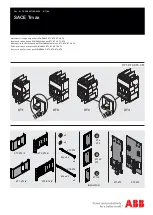
ABB | SACE Tmax XT
42 | © 2020 ABB | 1SDH001821A1002 - ECN000135670
Protections | 6 - PIN and security
Protections
Operating principle
The protection functions are available with all Ekip Touch models and versions.
Each protection is associated with a different signal (current, voltages, frequencies, powers, etc) but the
operating principle is the same:
1. If the signal measured exceeds the set
threshold
, the specific protection activates (prealarm and/or
alarm
).
2. The
alarm
appears on the display and, after a period of time (timing t
t
), depending on the protection
parameters set, can convert into a
trip command (TRIP)
transmitted to the internal Trip coil of the
CB.
NOTE:
• if the signal measured drops below the set threshold before the trip time has elapsed, Ekip
Touch quits the alarm and/or timing status and returns to the normal operating condition
• all protections have a default configuration: check the parameters and change to suit the
installation requirements before putting into service
TRIP
When the Ekip CI module is present, Ekip M Touch allows a different TRIP configuration to be selected so
that, if a trip occurs, a contact of the Ekip CI module connected to an external remote control switch is
commanded (Normal mode).
NOTE:
TRIP is always controlled by a command to the Trip Coil for protections I and G
Consult the parameters used with Ekip Touch MLRIU for further details (page 130).
References
Many of the protection thresholds are displayed in two different quantities: absolute value and relative value.
The relative value depends on the type of measurement:
Type of protection
Reference
Description
Current
In
Nominal current of the
Rating plug
Voltage
Un
Line-to-line voltage setting
Frequency
fn
Frequency setting
Power
Sn
√
3 x In x Un
Protections packages
The protections described in the following chapters are grouped into packages, the availability of which
depends on the model and version of the Trip unit, and on their ability to be installed as additional package:
Package
Page
Standard Protections
Voltage protections
Voltage Advanced protections
Frequency protections
Power protections
Adaptive protections
Motor protections









































